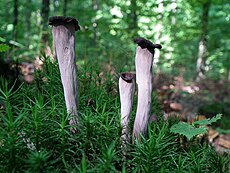Craterellus
| Craterellus | |
|---|---|
 |
|
| Craterellus cornucopioides | |
| Scientific classification | |
| Kingdom: | Fungi |
| Division: | Basidiomycota |
| Class: | Agaricomycetes |
| Order: | Cantharellales |
| Family: | Cantharellaceae |
| Genus: |
Craterellus Pers. (1825) |
| Type species | |
|
C. cornucopioides (L.) Pers. (1825) |
|
| Synonyms | |
| Craterellus sp. | |
|---|---|
| Mycological characteristics | |
| ridges on hymenium | |
| cap is infundibuliform | |
| hymenium is decurrent | |
| stipe is bare | |
|
|
spore print is cream to salmon |
| ecology is saprotrophic | |
| edibility: choice | |
spore print is cream
Craterellus is a genus of generally edible fungi similar to the closely related chanterelles, with some new species recently moved from the latter to the former. Both groups lack true gills on the underside of their caps, though they often have gill-like wrinkles and ridges.
The two most common species, Cr. cornucopioides and Cr. tubaeformis, are gathered commercially and, unlike Cantharellus, can be easily preserved by drying.
Molecular phylogenetics have been applied to the problem of discriminating between Craterellus and Cantharellus genera. Results indicate that the presence of a hollow stipe may be a synapomorphy (a trait corresponding to the evolutionary relationship) which reliably identifies Craterellus species. Cr. cornucopioides appears to be a single polymorphic species, while Cr. tubaeformis may be two separate genetic groups separated by geography.
C. odoratus
Pseudocraterellus sinuosus
C. ignicolor
western C. tubaeformis
eastern C. tubaeformis
Cantharellus ssp.
The genera Craterellus and Cantharellus have always been recognized as closely related. The whole group may be recognized by their lack of division into cap and stipe, and their rudimentary or missing gills ("false gills"). Originally Cantharellus was defined by Fries in 1821 to mean all these species together and then in 1825 Persoon separated some species off to create the Craterellus group, with Cr. cornucopioides as type species. Since then some authorities have tried to merge the two genera together again, but DNA studies now indicate that (with recent changes) each genus is monophyletic, and so they are likely to remain separate.
...
Wikipedia
